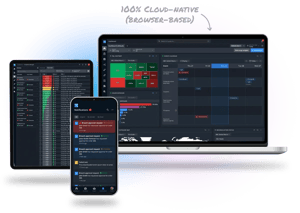
BlackRock Aladdin - Competitors and Alternatives
Limina's modern front-to-back system comes with slick workflows. The solution adapts easily to your workflows, without lengthly implementations.
We're an independent system provider - not an investment manager.
Note: All vendor information below is based on online, publicly available information as of 2025-07-02. Sources include company websites, review sites (G2, Gartner, TrustRadius and Capterra) and industry publications.
Why clients opt for Limina

We're a pure Software-as-a-Service (SaaS) provider, of cloud-based investment technology. We don't have a side business competing with you in investment management.


Managed upgrades that adhere to highest governance requirements of large managers. Become nimble through quick release cycles and self-service features.

What clients are saying
By adopting Limina's scalable platform, Avanza has launched 33% additional funds without having to scale its investment operations team. They achieved:
- Decreased dependency on single individuals - by replacing spreadsheets
- Improved operational efficiency - by increased automation
Genesis moved to Limina and achieved the benefits of a cloud-native environment (keeping governance & oversight intact):
- Lower IT costs
- Simpler BCP processes
- More efficient operations
What makes Limina different?
Modern user experience - Your way
- Full-feature access from browser and tablet, native mobile app & slick&efficient workflows
- Configure to fit your workflows
- Modular - use the modules you need, don't get forced to take all-or-nothing

All workflows & assets in one system
All the workflows you need - combined in one solution with powerful automation capabilities & built-in data controls.
All asset classes supported, including funds, alternatives, FX (and everything else)
Connect to anything & anyone
Greatly reduce the time spent on manual data input and extracts with Limina's powerful connectivity:
- Standard connectivity to the most popular data & service providers
- Easily build, schedule and maintain your own custom integrations in minutes to anywhere: custodians, internal tools, data warehouses, admins, and more

Partnership approach
We come from the buy-side, have been in your shoes and knows what you want from a vendor beyond a system:
- Dedicated service, by a team that knows your setup and your portfolios
- Ability to influence roadmap and get your requirements prioritised
- Direct access to our product management team, regardless of your company size

Efficient upgrades, integrations & changes save you money

See the next market leader in action
If you're looking to get ahead, and stay ahead, why not schedule a no obligation demo with us at a time to suit you?- 01 Aladdin
- 02 Limina
- 03 SimCorp
- 04 CRD
- 05 Thinkfolio
- 06 SS&C Advent
- 07 SS&C Eze
Best BlackRock Aladdin Competitors
In this article, we highlight some competitors and alternatives to BlackRock’s Aladdin. Our goal with the article is to assist investment managers like you who are researching which solutions to include in a procurement.
BlackRock Aladdin pricing can be a challenge. It's both a deep and broad platform covering sophisticated workflows front-to-back, and priced accordingly.
When evaluating functional coverage of competitors and alternatives to Aladdin, there has historically only been two options:
- Sophisticated but complex
Aladdin is built to service the world’s most sophisticated and largest asset managers. The downside is that the system is complex and hard to understand and pricing can be an obstacle. - Too simple
Some vendors are front-to-back systems as well, but lack the sophisticated level of Aladdin.
Limina IMS
The team at Limina, as former investment managers, understands the challenges of selecting a system. While we offer powerful investment management software, we believe in providing an unbiased overview. Consequently, we won't include ourselves in the comparison, but we encourage you to explore Limina’s solutions as a viable choice based on your unique requirements.
We’ve tried to make it easy for you to confirm whether Limina is a match for you or if Limina might not be your best choice.
SimCorp One (rebranded from SimCorp Dimension)
SimCorp One is a front-to-back system used by large investment management companies. The platform supports various asset classes and caters to global investment strategies.
Online reviews highlight data management capabilities and their own marketing emphasise the IBOR - compared to Aladdin.
Charles River Development (part of State Street)
Charles River Development's Investment Management Solution (IMS) is a robust competitor to Blackrock Aladdin enabling firms to optimise a large part of their investment processes. It has a broad functional set, including order and execution management and compliance monitoring.
Charles River services mostly large asset managers but also mid-sized managers. Online reviews note that scalability and flexibility of the solution are strong points.
S&P Markit Thinkfolio
Thinkfolio by S&P Markit is a software for portfolio management, modelling and order management. In that sense it's narrower than Blackrock Aladdin and doesn't contain an IBOR
Thinkfolio aims to enhance portfolio visibility and improve decision-making processes. The software started in Fixed Income but now covers multiple asset classes.
Thinkfolio was acquired by Markit in 2014, and then Markit was, in turn, acquired by S&P in 2022.
SS&C Advent: APX, Moxy, Genesis, Geneva
SS&C Advent has a set of solutions, for example:
- APX for portfolio administration and CRM capabilities
- Moxy for order management capabilities
- Genesis for portfolio management capabilities
- Rules Builder for pre- and post-trade compliance controls
- Geneva for portfolio accounting
The solutions integrate to enable end-to-end workflows.
SS&C Eze
Similar to Advent, Eze offers various solutions for different parts of the investment lifecycle:
Eze EMS (formerly known as RealTick) for execution management capabilities
Eze OMS for order management capabilities, including compliance
Eze PMS (formerly known as Tradar) for portfolio accounting
Just like Advent, Eze has been acquired by SS&C.







